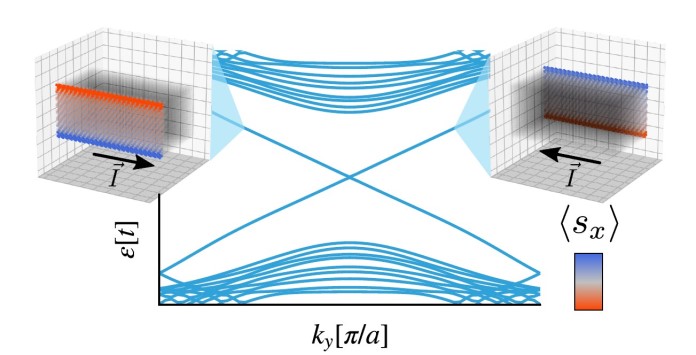Monday, 17 May 2021
Spin polarization effects at the hinges of 3D magnetic topological insulators
Simulations of spin polarization states on the surface of three-dimensional models of magnetic topological insulators —materials largely studied in spintronics— unveil the emergence of hinge spin polarizations, with opposite sign on opposite hinges. This study, carried out at the ICN2 and published in “Physical Review Letters”, also demonstrates the possibility to generate a large resistance switch in the sample, with important implications for the design of spin-sensitive devices.

Magnetic topological insulators are materials that behave as an insulator in the interior while they are conductive on the surfaces, as all topological insulators (TIs), and in addition exhibit magnetic properties. They are studied as platforms to investigate the anomalous Hall-effect (AHE) and its quantum version (QAHE), phenomena relevant to the development of electronic devices whose conduction is protected and without dissipation. Additionally, the conduction can encompass peculiar spin features. These effects are explored both in two- and three-dimensional systems, with the second ones presenting a quite higher level of complexity, since there is another physical dimension in which spin-polarization states are generated.
In a paper recently published in Physical Review Letters, Dr Pablo Perez-Piskunow, a senior researcher in the ICN2 Theoretical and Computational Nanoscience group, and Group Leader ICREA Prof. Stephan Roche present a study on the spin features of a three-dimensional magnetic topological insulator. The simulations of such structure, based on theoretical models, show the emergence of a hinge spin polarization (HSP), perpendicular to both the current flow and the magnetization direction of the 3D sample.
In 2D topological insulators, effects are studied due to the spin texture of topological edge states (which are pairs of states of opposite spins propagating in contrary directions, along opposite edges); when passing to the 3D counterparts, the “edge” states cover the whole side surfaces, i.e. the walls of the three-dimensional TI, and propagate along its hinges. The simulations performed by Dr Perez-Piskunow and Prof. Roche in models of 3D magnetic TIs reveal that such in-plane polarization reverses sign along the vertical direction, between the top and the bottom surfaces, with concentration of contrarily-polarized spin states at the hinges.
This peculiar local spin polarization allows obtaining a giant resistance that can be switched by either reversing the current direction or inverting the magnetization of the sample. This has been proved by simulating a transport setup, in which metallic leads connect to the whole walls of the 3D sample on two side surfaces, while ferromagnetic contacts connect to the other two walls only near the top hinges. The matching or mismatching between the spin current carried by the ferromagnetic leads and the spin polarization of the hinge states is what gives rise to the resistance switching.
The results of this study —which are valid for ferromagnetic, antiferromagnetic and canted-ferromagnetic topological insulators— are relevant to future design of spin-sensitive devices, with the possibility of manipulating the spin polarization of the currents.
This work has been supported by the European project "TOCHA" coordinated by ICREA Prof. Sergio O. Valenzuela, leader of the Physics and Engineering of Nanodevices Group.
Reference article:
Pablo M. Perez-Piskunow and Stephan Roche, Hinge Spin Polarization in Magnetic Topological Insulators Revealed by Resistance Switch. Phys. Rev. Lett. 126, 167701 – April 2021. DOI: 10.1103/PhysRevLett.126.167701

